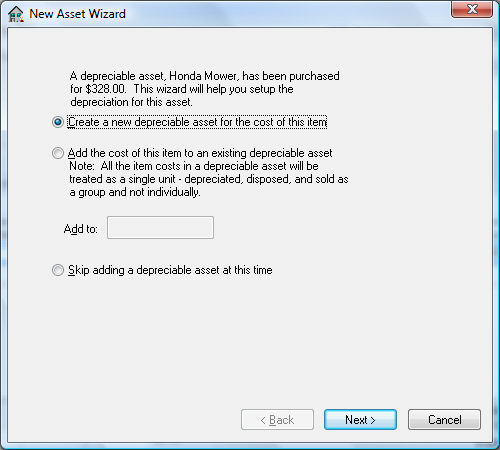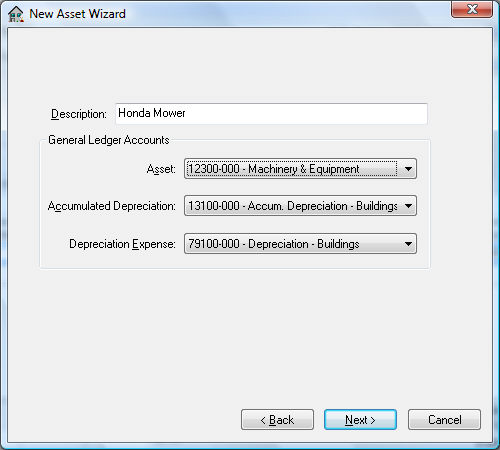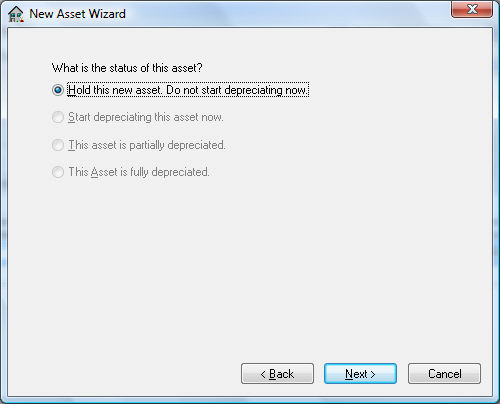Adding Fixed Assets from an Expense Invoice
How to enter a new fixed asset at the time of purchase
Complete the following steps to add a new asset into the depreciation system from an expense invoice at the time the item is purchased. NOTE: The following steps will not work in EBMS if the optional Depreciation module is not installed.
-
Go to Expenses > Invoices and P.O.s to open an expense invoice.

-
Enter a purchase order or expense invoice in the standard way with the exception of the General Ledger account. Click on the G/L Account lookup button. The General Ledger account must be set to an asset account that records depreciable assets.

-
The wizard to add depreciable assets will be activated each time an expense invoice is associated with a General Ledger account classified as Depreciable Asset. Review Adding or Deleting Fixed Asset Folders for more details on account classifications. The following wizard will be activated at the time the invoice is processed:

- Select the first option (Create a new depreciable item for the cost of this item) to create a new asset. Select the second option (Add the cost of this item to an existing depreciable asset) to add costs to an existing depreciable item. Click the Next button.

-
Select the appropriate asset category. Adding items can be greatly simplified if the General Ledger accounts and other defaults are properly set for each category folder (representing a group of assets). See Adding General Ledger Accounts for more details on adding folders. Click the Next button.

-
Enter an appropriate Description to identify the new asset.
-
Set the correct General Ledger Accounts for the new asset. The Asset account will be set to the G/L Account entered on the invoice. The Accumulated Depreciation account is an asset account used to record the accumulated depreciation. The Depreciation Expense account is an expense account that records the annual depreciation. Click the Next button.

-
Enter a Depreciation Method by clicking on the lookup button and selecting a method. This method may be changed at a later time if a method is not determined at this time. See Depreciation Methods for more details on adding or changing methods. See the following Changing an Asset's Depreciation Method section for details on changing the depreciation method.
-
The Depreciation Start Date will default to the date found on the expense invoice. The depreciation schedule will use this date to determine in which fiscal years the depreciation is scheduled.
-
The purchase Cost of the asset will be copied from the invoice.
-
Enter the estimated Salvage Value of asset at time of disposal. This amount will be deducted from the Cost to calculate the Depreciable Amount. (Depreciable Amount = Cost – Salvage Value.) Click the Next button to continue.

-
Select one of the following status options for the asset:
-
Hold this new asset. Do not start depreciating now. This option is the only available option if no depreciating method has been entered for this asset. The Hold option will record the asset but will not process any accumulating depreciation and is useful if the user wishes to obtain advice on the appropriate depreciation method. The asset status can be changed to a depreciating status at any time. See Changing an Asset's Depreciation Method.
-
Start depreciating this asset now. This option will cause the asset to start depreciating at the time of the next Monthly Process. See Depreciating Assets Using a Monthly Process for more details on processing depreciation.
-
This asset is partially depreciated and This Asset is fully depreciated. These options should not be used when adding new assets from an expense invoice.
-
Click the Next button.

-
Enter the Asset ID. Checking the option Display asset information upon wizard completion will open the Depreciable Asset window. Click Finish to complete the wizard.
See Viewing or Changing Asset information for more details on viewing or changing new asset information.